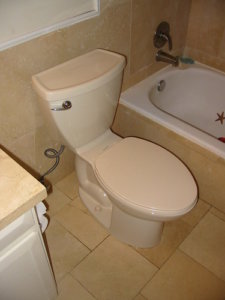Three Ways to Check if a Toilet is Leaking
Ensuring the longevity of your plumbing and home appliances is important to keeping your family safe and healthy, maintaining the value of your home, and ultimately saving you money. A properly working toilet will reduce water waste and maintain the health of your home’s pipes. Unfortunately, a leaky toilet is typically hard to detect until there has been a substantial amount of property damage and hundreds of dollars lost, if not more.
For the proactive homeowner, there are several methods you can use to check for a leak in your toilet before you make a call to a plumber. Read on to see the typical causes of a leaky toilet and three ways to check if a toilet is leaking in your home so you can get it taken care of as soon as possible, minimize costs for your wallet, and keep your family comfortable.
Typical Causes of a Leaky Toilet

A toilet leaking can be a chronic problem that goes unnoticed for a long time. Meanwhile, larger problems, such as rusted pipes, moldy floors, and weakening ceilings begin to mount. Luckily, the discerning homeowner will notice some telltale signs and suspect an issue. The fundamental cause of a leaky toilet is just wear and tear. Bolts loosen, the toilet has misaligned pipes and valves, or the wax rings that seals the base of the toilet to the floor has loosened, cracked, or become damaged. Some people with leaky toilets notice a damp feeling around the toilet, a spongy floor, or in two-story homes the ceiling under the toilet looks wet, has water stains, or is off-color. Some other less damaging signs of a leaky toilet that often go unnoticed are:
- When a toilet flushes without someone touching the handle, known as a phantom flush.
- A loose handle that you must jiggle to make the toilet stop running.
- A noisy toilet that sounds like running water, particularly when not in use.
- Having to hold the handle down to allow the tank to empty fully.
- An observable crack in the tank or bowl.
- A toilet that wiggles when you sit.
The Colored Water Test
The colored water test, commonly known as the dye test, is an inexpensive and effective way to test for a leaky toilet. You can choose to buy a specialized dye from a water or plumbing supply company or simply use some food coloring. You’ll want to use a color that is easy to detect, such as red or blue.
Remove the lid from the tank on the back of your toilet. Safely place it on a stable surface such as a countertop or the floor. Add several drops of coloring to the water in the tank. Make sure it is dark enough for you to detect and wait several minutes for the color to mix in well with the water in the tank. Don’t flush, and wait several minutes to check the bowl for any colored water. If you observe some of the dyed water has flowed into the bowl, there is a continuous flow of water from your tank to the bowl.
Turn off the water at the shut-off valve found at the back of the toilet and connected to the wall. There’s typically a small oval knob you can turn. This will ensure no more water is released into the toilet and minimize water waste until you can get the leak fixed. Most homeowners can repair the cause of this leak with some basic home maintenance tools without needing to call a plumber. This leak is normally because of a faulty flapper. It is inside the tank, and you can replace it yourself by purchasing the part from most home improvement stores.
The Pencil Test
Another method to help you check for a leaky toilet involves drawing a line on the inside of the toilet with a pencil — this is known as the pencil test. Remove the lid to the tank on the back of the toilet and place it on a safe and stable surface. Using your pencil, draw a line dark enough to see on the inside and back of the tank along the waterline.
Then, using the shut-off valve that is connected to the wall and runs to your commode, turn off the water supply to the tank. Wait half an hour to an hour and then go check on the water level in your tank. If you suspect a leak and the water level is still at the pencil mark, the leak may be at the refill valve on the left of most tanks. If the water level has dropped below the pencil mark, check for a leak at the flush valve in the middle of the tank.
Technological Sensors
Some homeowners prefer to take a preventive approach and consistently monitor toilets to catch a leak or malfunction as soon as possible. You can easily detect a water leak within your toilet by purchasing a water leak sensor at your local home improvement store. These monitors attach easily to your commode and will flash a red light and beep loudly as soon as the mechanism detects a leak. While the toilet is functioning properly, the light remains green.
Most of these helpful devices run about $20 and can be an inexpensive option to monitor leaks and maintain properly working toilets throughout your household. In some cases, such as an issue with the wax ring or a fill valve leak, it will be best to contact a professional.
By following some of these simple steps above, you’ll hopefully discover your tank and bowl are leak free. A proactive approach to monitoring your toilet and water usage is one of the best ways to save money and water by ensuring you have no leaking toilets. If you do find you need support for maintenance, repair parts, or have questions, contact us at Allied Plumbing & Heating Supply Co! We carry a wide selection of brand name toilets and parts to help you care for your plumbing and toilet needs.


